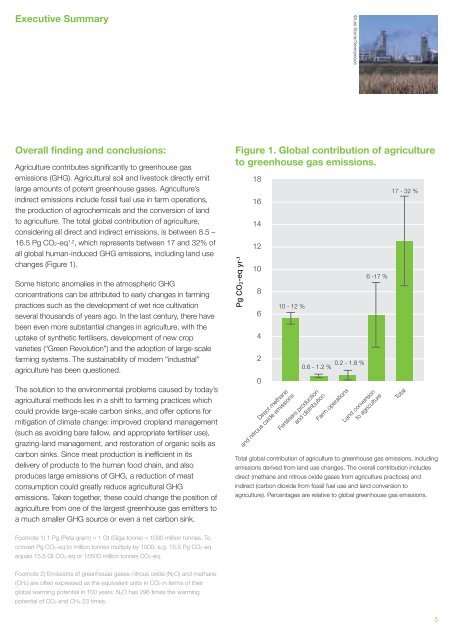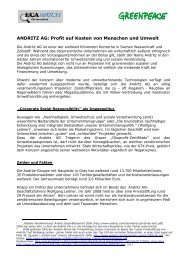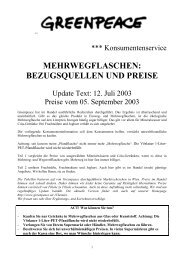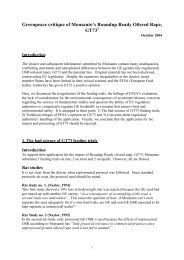Cool Farming: Climate impacts of agriculture and mitigation potential
Cool Farming: Climate impacts of agriculture and mitigation potential
Cool Farming: Climate impacts of agriculture and mitigation potential
You also want an ePaper? Increase the reach of your titles
YUMPU automatically turns print PDFs into web optimized ePapers that Google loves.
Executive Summary<br />
Overall finding <strong>and</strong> conclusions:<br />
Agriculture contributes significantly to greenhouse gas<br />
emissions (GHG). Agricultural soil <strong>and</strong> livestock directly emit<br />
large amounts <strong>of</strong> potent greenhouse gases. Agriculture’s<br />
indirect emissions include fossil fuel use in farm operations,<br />
the production <strong>of</strong> agrochemicals <strong>and</strong> the conversion <strong>of</strong> l<strong>and</strong><br />
to <strong>agriculture</strong>. The total global contribution <strong>of</strong> <strong>agriculture</strong>,<br />
considering all direct <strong>and</strong> indirect emissions, is between 8.5 –<br />
16.5 Pg CO2-eq 1,2 , which represents between 17 <strong>and</strong> 32% <strong>of</strong><br />
all global human-induced GHG emissions, including l<strong>and</strong> use<br />
changes (Figure 1).<br />
Some historic anomalies in the atmospheric GHG<br />
concentrations can be attributed to early changes in farming<br />
practices such as the development <strong>of</strong> wet rice cultivation<br />
several thous<strong>and</strong>s <strong>of</strong> years ago. In the last century, there have<br />
been even more substantial changes in <strong>agriculture</strong>, with the<br />
uptake <strong>of</strong> synthetic fertilisers, development <strong>of</strong> new crop<br />
varieties (“Green Revolution”) <strong>and</strong> the adoption <strong>of</strong> large-scale<br />
farming systems. The sustainability <strong>of</strong> modern “industrial”<br />
<strong>agriculture</strong> has been questioned.<br />
The solution to the environmental problems caused by today’s<br />
agricultural methods lies in a shift to farming practices which<br />
could provide large-scale carbon sinks, <strong>and</strong> <strong>of</strong>fer options for<br />
<strong>mitigation</strong> <strong>of</strong> climate change: improved cropl<strong>and</strong> management<br />
(such as avoiding bare fallow, <strong>and</strong> appropriate fertiliser use),<br />
grazing-l<strong>and</strong> management, <strong>and</strong> restoration <strong>of</strong> organic soils as<br />
carbon sinks. Since meat production is inefficient in its<br />
delivery <strong>of</strong> products to the human food chain, <strong>and</strong> also<br />
produces large emissions <strong>of</strong> GHG, a reduction <strong>of</strong> meat<br />
consumption could greatly reduce agricultural GHG<br />
emissions. Taken together, these could change the position <strong>of</strong><br />
<strong>agriculture</strong> from one <strong>of</strong> the largest greenhouse gas emitters to<br />
a much smaller GHG source or even a net carbon sink.<br />
Footnote 1) 1 Pg (Peta gram) = 1 Gt (Giga tonne) = 1000 million tonnes. To<br />
convert Pg CO2-eq to million tonnes multiply by 1000; e.g. 15.5 Pg CO2-eq<br />
equals 15.5 Gt CO2-eq or 15500 million tonnes CO2-eq.<br />
Footnote 2) Emissions <strong>of</strong> greenhouse gases nitrous oxide (N2O) <strong>and</strong> methane<br />
(CH4) are <strong>of</strong>ten expressed as the equivalent units in CO2 in terms <strong>of</strong> their<br />
global warming <strong>potential</strong> in 100 years: N2O has 296 times the warming<br />
<strong>potential</strong> <strong>of</strong> CO2 <strong>and</strong> CH4 23 times.<br />
Figure 1. Global contribution <strong>of</strong> <strong>agriculture</strong><br />
to greenhouse gas emissions.<br />
18<br />
16<br />
14<br />
12<br />
10<br />
8<br />
6<br />
4<br />
2<br />
0<br />
10 - 12 %<br />
Direct methane<br />
<strong>and</strong> nitrous oxide emissions<br />
Fertilisers production<br />
<strong>and</strong> distribution<br />
Farm operations<br />
©Les Stone/Greenpeace<br />
0.2 - 1.8 %<br />
0.6 - 1.2 %<br />
6 -17 %<br />
L<strong>and</strong> conversion<br />
to <strong>agriculture</strong><br />
17 - 32 %<br />
Total global contribution <strong>of</strong> <strong>agriculture</strong> to greenhouse gas emissions, including<br />
emissions derived from l<strong>and</strong> use changes. The overall contribution includes<br />
direct (methane <strong>and</strong> nitrous oxide gases from <strong>agriculture</strong> practices) <strong>and</strong><br />
indirect (carbon dioxide from fossil fuel use <strong>and</strong> l<strong>and</strong> conversion to<br />
<strong>agriculture</strong>). Percentages are relative to global greenhouse gas emissions.<br />
Total<br />
5










